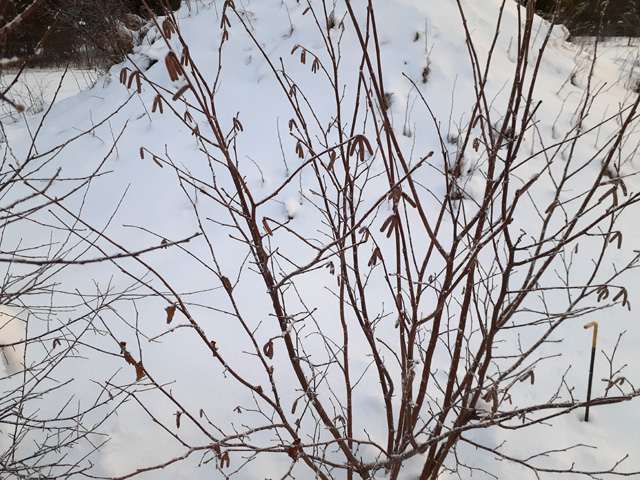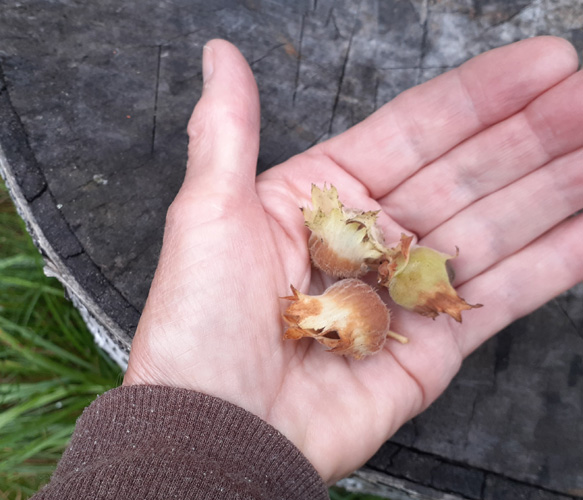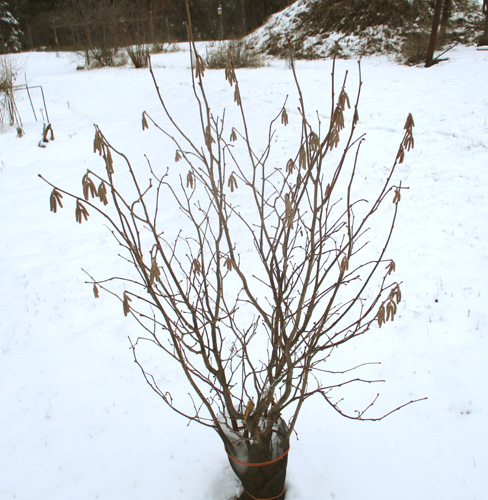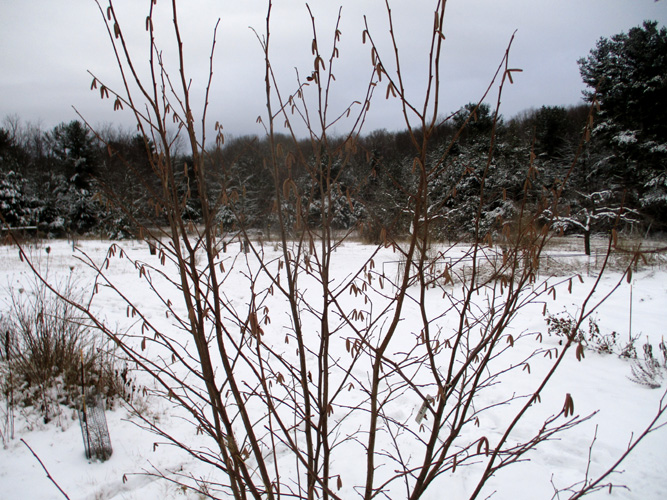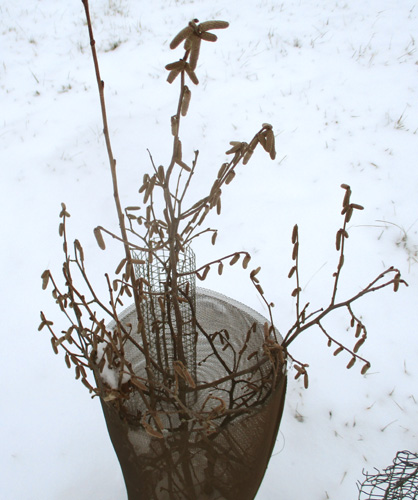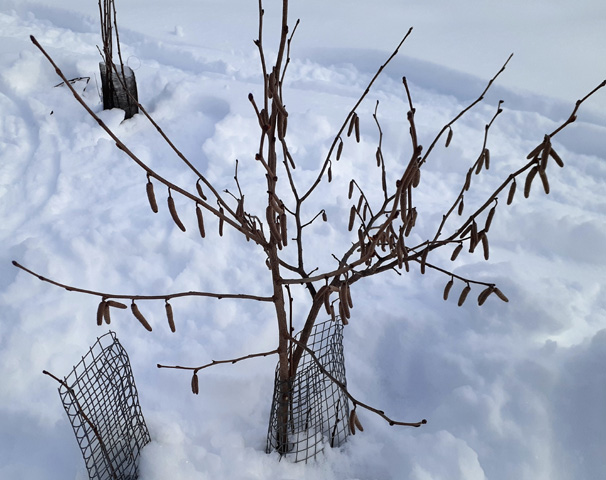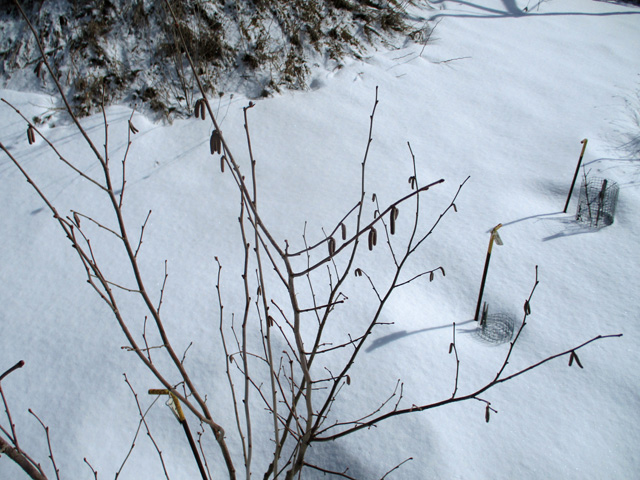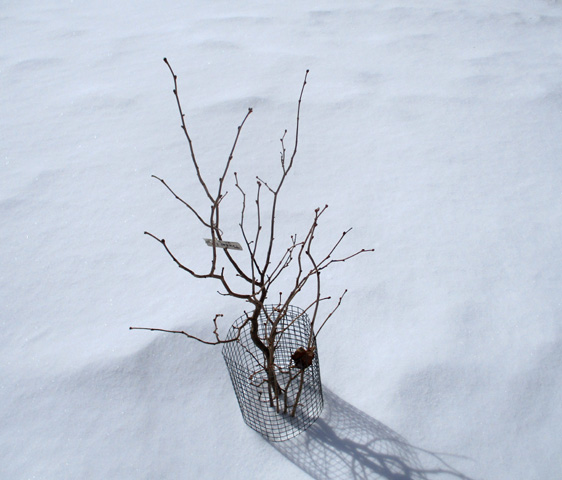|
| ||
|
Apples
Blueberries |
The ManyTracks Orchard Hazelnuts
Cousins of the Wild Ones
Four decades of Growing
Good Food
in Michigan's Upper Peninsula |
Q Hazelbert 1 '19 Precocious 1 '18 Trazel N '18 UMHDI Hazels |
|
We are blessed with numerous wild Beaked Hazelnut bushes (Colylus cornuta) on the edges of our woods. Some years they produce quite a few nuts, other years not so many or none at all. Only once did I pick the nuts, in an early year on our homestead, a rare year of good harvest and before the rodent population had a chance to establish itself. I learned how incredibly picky the nut husks are, and how small the nuts are -- but I finished with a full quart of nuts! I roasted them and we cracked and ate a few. Very tasty -- but oh so small and a lot of work for the little meat. I gave the rest to my Dad who maybe had more patience than we had. From then on the hazelnuts were the sole domain of the wildlife, as was intended. It was many decades later (2018) before I once again considered hazelnuts as a possibility for we humans. But these would be larger nuts, hybrids and selections by those pioneers of the slowly emerging commercial hazelnut industry in northern North America and Canada. Still in its early stages as they work for hardier selections, larger nuts, disease resistance, more reliable propagation, but slowly filtering out into the world of the backyard and small grower world. Every seedling planted is an experiment and it's fun to be a part, even in a very small way. Those that are hardier enough for our area are mostly open pollinated best selections of native hazels. 2024 - It was a tough year for the smallest plants due to the two month drought late summer but overall they all did OK. No nuts but Preco again was healthy, full of flowers and later catkins. TrazelS grew and looking more robust with quite a few catkins in fall, while TrazelN had just a few. Both had a few blighted leaves but not many. 2023 - In April I dug and transplanted the small Bert Sucker I'd marked, as well as moving SPC-2C7x closer to some of the other hazelnuts. Both large Precocious and short Bert had blossoms as well as lots of catkins early spring. There were fully open catkins as well as those which either didn't develop or were cold damaged. I wasn't surprised Preco didn't get pollinated with Bert so small and so far away, but to my surprise little Bert had three well hidden pretty green husks amongst the leave which I hoped had nuts inside. Preco has grown well and quick crowded so I cut out a few young but tall stems - unfortunately mistakenly took out one of the older good blooming stems instead! Sigh... But all the hazels did well in spite of the hot and dry season. End of September 4 new UMHDI hazels arrived from Hauser Nursery - one marked Bay OP Bulk and three labeled STG. They were in smaller tall plastic pots this time which were difficult to get out and rather tall & whippy. I cut off top half leaving 2-3 leaves, staking the whip when planting. Mild fall and they seemed to do OK. I think that will be enough hazels, 12, at least for now.
When wrapping the bushes with screening in late fall (vole protection) I was happily surprised to find a lot of catkins on TrazelN who is about shoulder high now, and the first few on small TrazelS. Finally Preco might have a chance at some pollen. Both Preco and Bert were full of catkins. Winter photos below, in that order:
2022 - The hazelnuts had a good year. No nuts yet but both Precocious and Bert are getting serious about it.
Precocious - This one
apparently loves its spot in the orchard, north of the garden by the watertank
hill, next to a large autumn olive. It has grown well, 5 1/2 ft tall, with
multiple stems. In late April I
pinned a small outer one to the ground (with a small cut below) to root for a
transplant for another part of the orchard. In early May the many catkins in the
bush were
in various stages of elongating and "opening", apparently having made it through
winter in good shape. And on closer inspection I spied flowers! Hazel flowers
are not at all the outgoing on-stage types. They are small, cute, red, and there
were many. However, hazels need to be cross pollinated by another, different,
unrelated hazel, via wind, and the only other possibility for Preco was small
Bert with just two small flowers almost 70 feet away. I had plans for one of the
closer Trazels to pollinate Preco but it wasn't in the mood yet. Such is life in the
pollination world. The native wild hazels were also flowering but they are
farther away and I'm not sure that they can pollinate the orchard hazels. HazelBert - Young Bert is looking good, still on the smaller side, bit under 3 feet (it's only 3 yrs old and is said to be a smaller bush) but growing new stems already. Its catkins wintered well and as stated above there were two flowers! Too early for nuts yet even if pollen from Precocious could make it the 70 feet but one has to start somewhere and Bert is obviously an early starter. He put out even more catkins this fall.
Trazels - TrazN is growing
into a nice bush, about 4 ft tall now. No catkins yet, and it did have blight spots on some leaves
(wild hazels also had some blight this year) but I removed them and overall the
plant is very healthy.
UMDI - There has been a lot
of attention and research given to hazelnut planting for commercial production,
with some of this filtering down to the home market. The Upper Midwest Hazenut
Development Initiative (UMDI) group is active for mostly large growers but one
farm involved, Hauser Farm in Bayfield, WI, sells small quantities of selections
to the public so we can take advantage of the early research and selections and
not have to wait for something to get into the market. So I purchased two open
pollinated seedlings with non-exotic names of "Q09 Bay-op" and "R03 & R42 SPC-2C7-op",
known as Bay and SpC for now. 2021 - All hazels are doing fine. Precocious is ahead of the flock and in the fall I realized it has catkins! A dozen or so. It wasn't until later in the winter than I really looked at the others more closely and found that little HazelBert also has a few catkins! It's a little early to expect nuts (most folks say their first harvests were several years after first finding catkins) but suddenly I'm seeing them as possible nut producers not just pretty shrubs. I hope the Trazels will not be far behind. 2020 - The northern most Trazel is finally gaining speed and looking fine. The southern Trazel is smaller but is healthy. Precocious definitely has more umph and is already a multi-stem small bushlet. HazelBert wintered well and looks good. 2019 - Precocious is growing well, looking good. The Trazels are slow but alive. I added a new hazel from Fedco -- a HazelBert, C. americana (Graham x Wrinkler) x C. avellana (Skinner) ((developed by Fred Ashworth 1920)) , planting it between the Regent Juneberries, just across the aisle from the Trazels. Small but healthy it established well. 2018 - With my new orchard becoming established I was looking for bushes and shrubs to fill in between the fruit trees. Hazelnuts were an obvious choice given their growth habits and native cousins that grow so well here. But I was somewhat reluctant. The hybrid hazel selections, though with larger nuts, are still not as hardy as the wild ones. The plants survive but the catkins and flowers sometimes don't, which sounded a lot like my struggle with plums. And I knew well how successful the squirrels and chipmunks and others were at harvesting at that first moment of mature-enough, giving little chance for humans to get the nuts. But I decided to go for it anyway, hoping for nuts someday but also appreciating the attractive bushes themselves. I ordered and planted two Trazels (C. columa x hybrid open pollinated) and one Precocious (C.americana x avellana) from Oikos Nursery in downstate Michigan. They have been working with and selecting hazelnuts for decades, and said these would pollinate each other. Hazelnut bushes produce both male catkins and female flowers but they require cross-pollination from another not-related plant, but one of the right variety. And since they use the wind to carry that pollen from one to the other they need to be fairly close to their pollinating partner(s). So siting the plants took some thought, particularly since by now the orchard spaces have filled with few spots available. But I found room. The Precocious in the strip between the garden and the tank, east of the well growing Collet Apple. The Trazels went on either side of Black Oxford Apple, hopefully all close enough to each other for pollination. Unfortunately the two small Trazels didn't grow but Oikos sent replacements in the fall. The Precocious took well to its new home. My hazelnut family was on its way. Copyright © Susan Robishaw |
||
